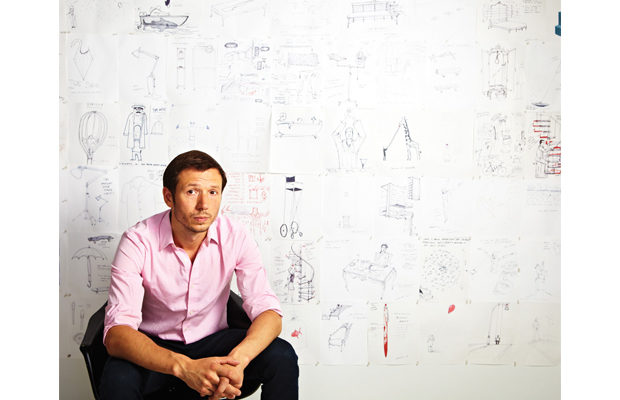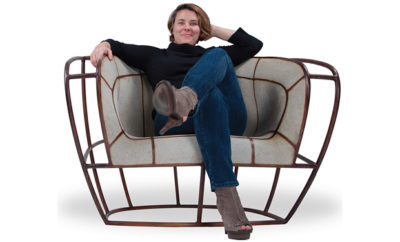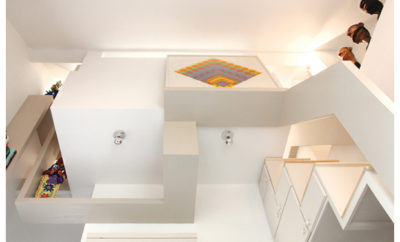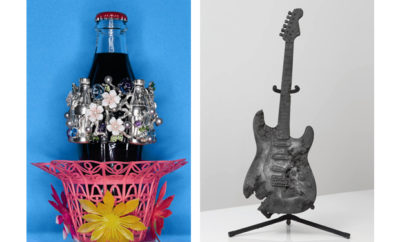 Sebastian Errazuriz in his studio in front of his wall of sketches, 2014. Jason Falchook Photo.
Sebastian Errazuriz in his studio in front of his wall of sketches, 2014. Jason Falchook Photo.
Feature
Defying Gravity
The Art,Design, and Craft of Sebastian Errazuriz
ONE HAZY DAY IN AUGUST 2013 Sebastian Errazuriz stood with fellow artists on Rockaway Beach, New York, as a competitor in Creative Time’s second annual Sandcastle Competition. While other participants mounded and molded the sand, Errazuriz made an outline on the ground and poured bucket after bucket of water to “paint” a subtle silhouette. In slightly darkened sand the finished product conjured the shadow of a jet approaching Manhattan.
Although his entry did not break the rules of the competition, one could argue that Errazuriz most certainly did not build a sandcastle. (Nor did he win the sandcastle contest.) But what does it matter? Unlike the ephemeral sand creations themselves, the poignant impact of his gesture—a startling demonstration of how something as innocuous as an airplane’s shadow still haunts a post 9-11 world—lingered and lingers still.
Redefining terms and twisting the perception of iconic images are the wonderfully confounding hallmarks of Errazuriz’s work. The thirty-seven-year-old Chilean keeps a studio in Brooklyn, where at any given moment he toys with a dozen or more projects that resist classification— conceptual furnishings or quasi-functional sculptures—each of which is meticulously designed and constructed. His dual commitments to conceptual rigor and impeccable craftsmanship set him apart from those who excel at one while missing the other. Rather than delving into a potentially sophomoric debate over the definitions of “art,” “design,” and “craft,” it suffices to say that Errazuriz blurs all the boundaries in ways that make one wonder why anyone bothers with labels at all. The work delivers with such verve that arguing over what to call it becomes moot.

The Magistral cabinet, 2011, guards and obscures its contents by way of eighty thousand bamboo skewers. Collection of Clarissa Alcock Bronfman/Ari Espay Photos

He has no shortage of strong ideas. A prolific sketch artist, Errazuriz captures them on paper as they come and tacks them up on his studio walls for further consideration. Beauty alone is insufficient; every work must seduce and provoke. The precise issues he tackles are wide ranging, but they boil down to heady themes: life and death; morality; and social, political, or economic injustice. The Boat Coffin enables its user to end life on his own terms and to exit with style. The Occupy Chair functions as a protest sign and a folding chair. But, transformed into a fetish by its display at a major art fair it becomes a Trojan horse, carrying the cries of the 99 percent into the homes of the collectors in the 1 percent.

Occupy Chair, 2012, carries the message of the 99% into the homes of the 1 %.
At other moments Errazuriz provides mental puzzles devoid of subject matter, just for the purpose of flexing the mind. His favorite motif for this exercise is the cabinet, which is literally a box that he can deconstruct in countless ways to remind viewers that they can still be surprised and that nothing is what it seems. The latest in this series is the Explosion, a minimalist maple, glass, and stainless steel credenza recently acquired by the Carnegie Museum of Art. On closer inspection, this tidy box looks to defy basic physics as the entire facade expands to startling proportions. Some of his previous game-changers include the Porcupine, which opens with an onslaught of hinged and ebonized wooden “quills”; and the Kaleidoscope, a staid walnut sideboard with an astonishing mirrored interior revealed through peepholes at either end.
Once Errazuriz has an idea, his execution is direct. It boils down to elegant visual communication design. He creates objects, images, or experiences that evoke a specific “aha!” in the mind of the beholder, enabling her to see something that was already there. The communicative act must be clear, devoid of distractions, succinct. As in a map or diagram, if the user does not get it, then the work is failing.

Explosion, 2014, in maple, glass, and steel, is a cabinet that expands to startling proportions via sliding dovetails.
In order to pack the most visual and cognitive punch, Errazuriz plucks existing symbols to appropriate the substance of cultural memory. Cabinets are standard and banal containers for the stuff of life. Desks and tables are places for routine thinking or eating. Motorcycles are modes of transportation but also symbols of power, masculinity, freedom, or folly. Birds are lovely, delicate, and fleeting. Errazuriz relies on his audience for this preexisting sub- conscious knowledge and then intervenes in ways that change the message. He disrupts the expected narrative, challenging assumptions about what things are and what they mean.
One example is the Narcissus desk, which features a mirrored top and inset niche that physically surrounds the user with her own reflection. Rather than a place for productive work the desk becomes a potentially lethal distraction. Errazuriz could easily have created a desk from scratch, but his belief in the power of existing forms led him to rework a rococo style bureau plat instead. Complete with its original brass mounts and richly burled veneer, the ready-made desk creates a befitting aura of luxury and excess that contributes to the overall impact.

The mirrored glass inside Errazuriz’s walnut Kaleidoscope, 2013, delights viewers with a riot of visual pleasure.
Found plant and animal matter also hold a special place in his heart as objects that were once alive and therefore carry a powerful emotional charge. Branches, trunks, and taxidermy birds appear in numerous objects, such as his Duck Lamp, which gave a found fowl with a broken neck new life as a bizarrely compelling task light. Speaking about this first foray into taxidermy, he recalls that it felt morbid and wrong, yet naively beautiful at the same time.
In all of these pursuits, Errazuriz recognizes that the mode of delivery is as important as the idea and the image. Materials and perfect execution are critical. His dedication to detail leads to some of the most tedious efforts for him and some of the most rewarding elements for the audience. The Explosion Cabinet began some five years ago as a quick sketch of a woman reaching into a cavity of horizontal rails that expanded at her touch. A three-dimensional digital rendering in 2012 showed the incredible visual and experiential promise, but the challenges for physical execution were significant. After six frustrating months of attempting to solve the mechanical conundrum with magnets, Errazuriz turned to one of the oldest tricks in the cabinetmaker’s book: the sliding dovetail. His choice of maple with its tight blond grain paired with a stark stainless steel base lent just the right modernist note.

Porcupine, 2010, inspired by samurai armor, the cabinet unfurls by means of hinged quills of lacquered rauli wood.
Another flawlessly detailed work is Time Lapse, a racing motorcycle and memento mori conceived and designed by Errazuriz and executed in collaboration with the Worth Motorcycle Company and NYC Norton. Built around a vintage engine, the bike lacks the usual excesses of paint or badges. Instead, it sports a streamlined metallic housing of custom, hand- hammered parts. As a machine and a function- al object, it is breathtaking. But the clincher is the tiny coffin-like cavity in the body, against which the rider presses his own chest, containing a small taxidermy bird. Heart to heart, it serves as a chilling reminder of the margin between life and death and the inherent and sublime danger of riding a motorcycle.
Again and again Errazuriz delivers work that is strong across numerous axes: conceptual, communicative, aesthetic, functional. He makes it look deceptively simple, which begs the question of how one arrives at such an effective, multifaceted approach. A native of Santiago, he spent nearly a decade of his youth in London while his father pursued a PhD in art education. Steeped in the old masters of his father’s slide lectures and the hallowed halls of the city’s greatest museums, Errazuriz developed a keen appreciation for the history of art and internalized an exceptionally high standard for greatness. Time passed in his grandfather’s workshop also instilled admiration for the craft of woodworking. Having no desire to become an artist unless he could make a serious contribution, he wandered to the seemingly safer realm of the applied arts, receiving his undergraduate degree in industrial design in Chile. But purely practical or decorative pursuits were not enough, and Errazuriz eventually moved to Manhattan to complete an MFA in fine art at New York University.

Duck Lamp, 2004, is a beautiful and macabre repurposing of a taxidermy bird as a task lamp.
After a decade of professional practice, it is fair to say that Errazuriz has made substantive contributions, yet in what guise? That of an artist? A designer? A craftsman? The answer is probably a hybrid of these and more, and only time will render his ultimate legacy. However, as long as he continues to bring forth overlooked kernels of truth and resonance and to deliver those messages in such compelling packages, he will remain an important figure to watch. So, regardless of which field usually holds the most interest for you—art, design, craft, or yet another—take a second look at Sebastian Errazuriz. There is something there for everyone.
Sebastian Errazuriz: Look Again, the first museum survey of Errazuriz’s work, is on view at the Carnegie Museum of Art in Pittsburgh through January 12, 2015. He is also the subject of exhibitions this fall at the Cristina Grajales Gallery and Salon 94 in New York.












